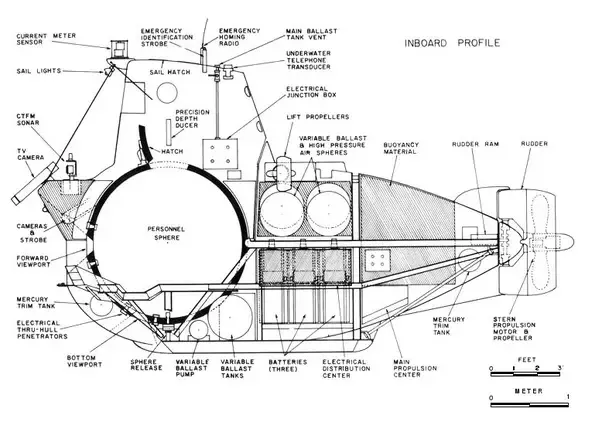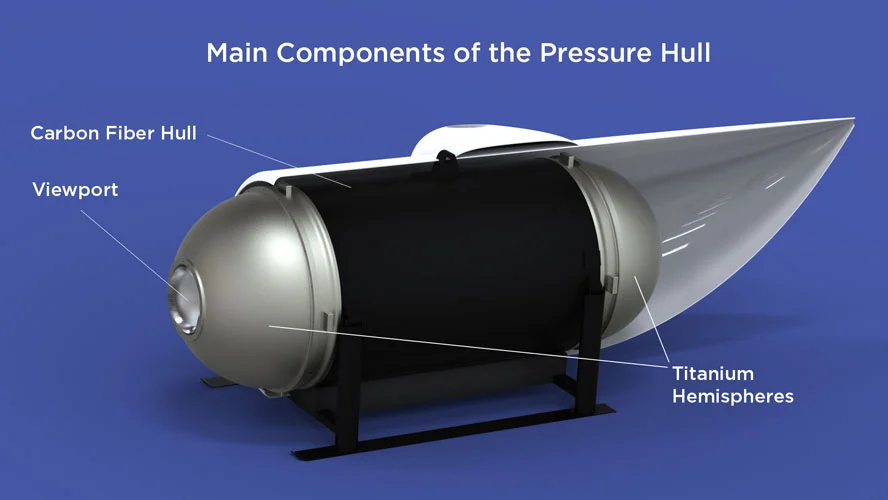Titan Submersible imploded on the way to the Titanic wreckage on 18 June 2023 tragically killing all five passengers.
We will analyze what might have gone wrong, trying to cover all the aspects of this disaster.
Traditionally, deep-sea submersibles have been constructed in a spherical shape using titanium, enabling them to withstand the extreme forces exerted by the ocean’s depths.
Sphere-shaped submersibles and titanium materials can sustain extreme pressures. Made of a single material (Titanium) the sphere is geometrically the strongest shape against external pressure forces.
Evolution of Deep Underwater Submersibles
Throughout history, deep underwater submersibles have played a pivotal role in expanding our understanding of the ocean’s depths. Early submersibles were predominantly spherical in shape, designed to endure the tremendous pressure encountered in the abyssal zone.

The advent of spherical submersibles marked a significant breakthrough, as their symmetrical structure allowed for equal distribution of pressure across their surface, ensuring maximum strength and durability.
Constructed from titanium, these sphere-shaped vessels provided exceptional resistance against the crushing forces of the deep. Titanium, renowned for its high strength-to-weight ratio, corrosion resistance, and structural integrity, became the preferred material for deep-sea exploration.
By withstanding the tremendous pressures at extreme depths, titanium spheres enabled scientific investigations and discoveries in previously unexplored underwater territories.
Deep-sea submersibles equipped with titanium spheres have proven their capability to withstand pressures exceeding 1000 atmospheres (approximately 100 megapascals), allowing dives to depths reaching 10,000 meters or more.
At such depths, the hydrostatic pressure exerted by the overlying water column can exceed 1000 times atmospheric pressure, subjecting the vessels to extreme conditions that challenge both their structural integrity and human resilience.
The Implosion of the Titan Submersible, Shape and Material Considerations
The ill-fated exploration mission to the Titanic wreckage witnessed a tragic incident involving a unique submersible vessel. Unlike conventional designs, this vessel deviated from the traditional spherical shape and featured a cylindrical body with titanium end caps.
To enhance structural integrity and pressure resistance, the cylindrical body was multi-layered with 5 inches (12.7 cm) thickness of carbon fibers.

Preliminary investigations into the catastrophic implosion have raised questions regarding the vessel’s unconventional shape and composite materials used. The spherical shape of traditional submersibles ensures an even distribution of hydrostatic pressure, minimizing stress concentration points.
In contrast, the cylindrical design may have introduced vulnerable areas prone to stress accumulation.
While carbon fibers possess excellent strength-to-weight ratio properties, their ability to withstand extreme pressures, particularly in submersion scenarios, remains a subject of ongoing research.
The interaction between the carbon fiber layers and the intense hydrostatic pressures experienced during the vessel’s descent may have contributed to structural failure, ultimately leading to the implosion.
Further analyses are required to determine the specific failure mechanisms and potential material weaknesses in the cylindrical vessel. A comprehensive investigation encompassing structural design, material properties, manufacturing processes, and the response of carbon fibers under extreme pressure conditions will shed light on the factors that led to this devastating incident.
What Was The Target Depth of The Titan Submersible?
The target was to reach the Titanic wreckage. While the implosion is believed to have happened close to the target area (to be verified). Current information confirms that Titan Submersible lost communication with the mother ship at 3500m (11,483 feet). That’s the moment that most experts believe the implosion happened.
The wreck of the Titanic rests at a depth of approximately 3,800 meters (12,500 feet) on the ocean floor. This iconic ship met its tragic fate in the North Atlantic Ocean on April 15, 1912, sinking after colliding with an iceberg.
Over the years, numerous expeditions have ventured to the Titanic’s resting place to explore and document the wreckage, shedding light on this historic event and offering insights into the ship’s final moments.
The extreme depth of the wreck presents significant challenges for exploration, requiring specialized submersibles and advanced technology to reach and study this submerged memorial.
The Most Applausible Theories on Why Titan Imploded
As of today 03 July 2023, an investigation is still going on to recover the remains of the Titan. At this point, we can only theorize based on some facts on why it imploded.
1. The max calculated depth allowed for the Titan Submersible
Its technical specifications were 4,000 meters (13,123.36 feet) of depth on paper. While the exploration area is located at 3,800m (12,500 feet) on the ocean floor.
It is clearly visible that the tolerance is very small at just 5%, this is a remarkably disturbing fact. In engineering, the tolerances should be much higher, in the range of 30%. Imagine elevator cables being designed for holding 4 tons of weight and being used for working with 3.8 tons. It is a clear indicator of an imminent disaster.
2. The cylindrical shape of the hull is atypical
It is said that they used this shape to accommodate more passengers.
Since 1932 it was well-known that going to significant depths, the hull should be spherical. This is because the forces exercised on it are better distributed resulting in the structure being way more resistant.
3. The front plexiglass window was certified for a depth of up to 1300 meters (4,265 feet)
This is a mind-blowing fact of which the Titan Submersible staff were well aware. They chose to ignore this crucial technical detail which might be the culprit of the disaster.
4. The hull was multi-layered with carbon fiber up to a thickness of 5 inches (12.7 cm)
While carbon fiber is known for its strength, the research for this application is not definitive. Other than that, the layers of carbon fiber should be sticking perfectly to each other the whole time. It is speculated that the fatigue they had suffered during previous submersions and tests, might have compromised them.
In the following video, we can see the Actual Carbon Fiber Hull Winding Of The Titan Submersible.
Obviously, this kind of wrapping looks like it was supposed to withstand internal pressure rather than an external one. In the aviation and space industry, carbon fiber is successfully used to withstand expanding pressure.
The Possible Missing of The 18th Bolt Theory
There is a voice circulating online that a missing bolt from the viewport frame might be a cause of the disaster. This can not be true because the pressure is exercised from outside, making the viewport frame sit way tighter.
At those depths, even removing all the bolts would make no difference as the forces are pressing the viewport against the titanium cap. The only thing I can think about is the bolt hole itself rather than its function as a viewport tightener.
Could it be possible that the bolt itself is a sealant, and missing it would expose a bolt hole that leads to thinner material? To learn this we need the actual design of that part but it is highly unlikely to be the culprit of the issue.
In Comparison, How Deep Can a Military Submarine Go?
Military submarines, the epitome of technological prowess and stealth, possess exceptional capabilities for submergence into the ocean’s depths. With their robust construction and advanced engineering, these formidable vessels can descend to considerable depths.
Public information is that they can operate at depths up to 800 meters (2,624 feet). Other specialized military submarines can go even deeper, however, none can go as far as the ocean floor where the Titanic wreckages lay.
This fact alone shows how challenging is to reach deeper and how important is flawless engineering.
What Do Experts Say on This Case?
It looks like most experts do agree with each other on what happened to the Titan Submersible. Recovering its wreckages could shed more light on this disaster dynamics.
US Capt. Alfred Scott McLaren
According to retired US Capt. Alfred Scott McLaren, in an interview on CBS News on 27 June 2023 theorized that the implosion happened because of the use of three dissimilar materials in the build of the Titan Submersible. Namely, these materials are Fibre Carbon, Titanium, and Plexiglass.
Basing on the fact that these materials have different molecular properties expanding and contracting at different paces. This alone would cause massive implications to the overall body structure, making it vulnerable when under severely stressful conditions.
James Cameron (Titanic movie director)
Mr. James Cameron the director of the emblematic Titanic movie is an expert in the field. He has dived multiple times at the Titanic wreckage exploring it for the movie but has also dived beyond it in other areas. He is a well-known authority in the deep-diving community.
According to Mr. James Cameron, the engineering of the Titan submersible was inadequate for such a mission. He blames the innovative use of multi-layered carbon fiber to protect the hull.
Carbon fiber and similar composites are used in aerospace successfully to withstand internal pressure rather than outer pressure. And this is a very well-known fact among deep-sea engineering experts – he said.
I find his explanation meaningful and very interesting for further investigations that will shed more light on this tragedy.
David Lochridge
Former OceanGate’s director of marine operations David Lochridge warned CEO Stockton Rush. Pointing severe engineering flaws in the construction process.
The main points include the ignoring of the safety standards, use of glue, carbon fiber, etc. Considering this setup is completely dangerous for the life of the passengers.
Lochridge was then fired from the company, while not agreeing to close the eyes on these flaws.
Full Communication Transcript Leaked
The following communication transcript has leaked online, the mothership communicating with Titan Sub.
[07:52:34] [POLAR PRINCE] clear for descent. Enjoy the ride
[07:54:07] [TITAN] Descending now
[07:58:16] [TITAN] Launch sequence complete, rdy?
[0800:39] [POLAR PRINCE] all clear
[08:01:11] [TITAN] Proceeding.
[08:03:09] [POLAR PRINCE] Enjoy the dive gentlemen.
[08:19:53] [POLAR PRINCE] you’re 15 minutes into the dive, current depth. Systems check, please.
[08:21:28] [TITAN] Systems check complete, all in order. All lights are green. We are 756, proceeding.
[08:22:41] [POLAR PRINCE] Thank you. Proceed.
[08:34:02] [POLAR PRINCE] 30 minutes in, update please.
[08:34:57] [TITAN] All systems are functioning normally. We’re in good shape. Continuing our descent as planned.
[08:36:05] [POLAR PRINCE] Superb, proceed.
[08:49:10] [POLAR PRINCE] Over 45 minute mark. Current depth? Confirm status.
[08:51:30] [TITAN] Depth at 1934. All systems stable and descent continuing as planned. Happy crew.
[08:52:28] [POLAR PRINCE] Excellent!
[09:01:46] [POLAR PRINCE] You’re at the hour mark.
[09:02:13] [TITAN] All is smooth sailing here.
[09:15:21] [POLAR PRINCE] You are at 75 minutes, depth? Status? Do you need to adjust velocity?
[09:17:50] [TITAN] All under control. At 2960. No adjustments needed. We’re enjoying the ride.
[09:19:03] [POLAR PRINCE] Understood
[09:28:16] [TITAN] we’re noting an alarm from the rtm
[09:28:35] [TITAN] reducing velocity descent depth 3433
[09:28:47] [POLAR PRINCE] Understood. Do you need to ascend?
[09:30:55] [TITAN] no change with thrust the rate of descent is increasing. At 35. Going to release the ballast now. Standby.
[09:30:55] [POLAR PRINCE] Yes, agree. Release the ballast.
[09:32:12] [TITAN] No improvement. Preparing to jettison the frame.
[09:33:00] [POLAR PRINCE] Affirmative. Update when able. RTM indicator status?
[09:35:48] [TITAN] frame jettisoned multiple attempts needed. But starting the ascent now.
[09:36:33] [POLAR PRINCE] Multiple attempts? What is your status? RTM indicators? Depth?
[09:37:38] [POLAR PRINCE] Update please when able.
*[09:38:09] [TITAN] crackling sound at aft
[09:38:44] [POLAR PRINCE] Can you identify source? RTM indicators status?
[09:40:12] [TITAN] neg
[09:40:40] [POLAR PRINCE] RTM status?
[09:42:12] [TITAN] trying to run diagnostics. Ascending now. But very slow. Sounds have subsided. Global RTM alert active all red.
[09:42:57] [POLAR PRINCE] Understood. Any codes? Depth? Ascent rate?
[09:43:16] [POLAR PRINCE] Updates when able please.
[09:42:42] [TITAN] slow ascent in progress. quarter predicted. Unclear why rate is small. No indicator. At 3476. Aiming for the surface.
[09:44:03] [POLAR PRINCE] We are talking it over with the engineer, standby.
[09:45:11] [POLAR PRINCE Depth and status please. What’s the wattage on upwards thrust?
[09:46:37] [TITAN] reading red on the A power bus. I switched to B. at 3457m more sounds aft.
[09:47:19] [POLAR PRINCE] Understood, continue ascent. Talking to Carlos about power bus situation right now. Standby.
[09:48:49] [POLAR PRINCE] We are activating recovery procedures. Carlos is requesting wattage output from bus B. Status update please. Velocity of ascent?
[09:50:09] [POLAR PRINCE] We’re not receiving you. Update please.
[09:51:16] [POLAR PRINCE] Status and depth report.
[09:53:08] [POLAR PRINCE] We need you to respond with status and depth. Carlos is requesting wattage update on thrusters.
[09:55:01] [POLAR PRINCE] We are unable to read you. We are moving to recovery coordinates. Report if you read.
[09:57:22] [POLAR PRINCE] Please respond if you’re able.
Engineer Jeff Ostroff reviews the leaked Titan Sub transcript. In his YouTube video, he analyzes and concludes that the Titan Sub was descending way faster than expected. Watch his very interesting full video: LEAKED Titan Sub Transcript Shows Crew In Battle For Lives.
Conclusion
The exploration of the deep sea and its submerged treasures has long fascinated humanity. The historical success of titanium sphere-shaped submersibles, in terms of their ability to withstand extreme pressures, has fueled our thirst for knowledge.
The implosion of Titan has emphasized the importance of carefully considering shape and material selection for submersible construction. Showing once again that certifications and flawless engineering are never useless.





